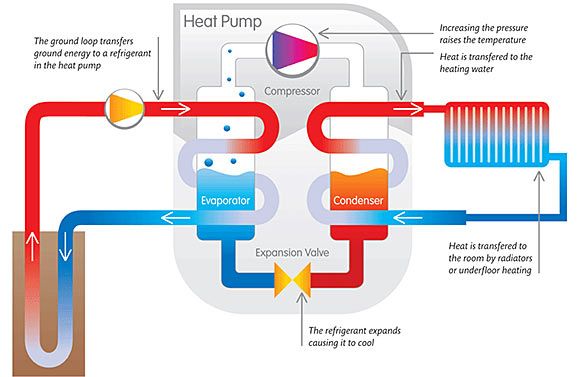|
redshirt posted:Domestic generation has to be part of any future energy mix. I live in central Minnesota. Solar panels arn't going to be very useful to me most of the time, and as for geothermal? Forget it. I don't care what kind of subsidies get put in place, none of them are going to pay for drilling miles straight down.
|
|
|
|

|
| # ? May 12, 2024 19:28 |
|
-Troika- posted:I live in central Minnesota. Solar panels arn't going to be very useful to me most of the time, and as for geothermal? Forget it. To clarify, he's not talking about drilling down to magma but taking advantage of the fact that the soil's a uniform temperature of 55 degrees about 10 feet down most places and you can use that to heat and cool your house. http://en.wikipedia.org/wiki/Geothermal_heating
|
|
|
|
The thing is the heat available changes pretty drastically depending on location: Additionally if you have too many people attempting to use geothermal in the same area at once, you can end up with reduced energy availability. Using geothermal for long term electricity production is particularly vulnerable to this.
|
|
|
|
Perhaps there's a better word for it, but home geothermal use could be used by just about everyone - you're not tapping magma for heat, but rather the generally stable ground temperatures 10-50 feet below the surface, which are usually around 55 degrees worldwide. Free heat, which is then boosted for heating purposes, or brought directly into the house for cooling purposes. As for solar, almost all parts of the continental US are good enough for solar. Consider German use of solar, and then they have less available solar potential then all of the continental US. I live in Western Maine in the mountains - cold and stormy. And yet this past year I had almost no electric or heating bill with a solar/geothermal combo. Yes, it costs a bit more upfront, but with tax credits and annual savings, the whole thing will pay for itself in about 6-8 years.
|
|
|
|
redshirt posted:Perhaps there's a better word for it, but home geothermal use could be used by just about everyone - you're not tapping magma for heat, but rather the generally stable ground temperatures 10-50 feet below the surface, which are usually around 55 degrees worldwide. Free heat, which is then boosted for heating purposes, or brought directly into the house for cooling purposes. If everyone in an area is tapping it, it can cause the ground temperature to change such that it becomes less effective for everyone. This map has nothing to do with going down to magma levels. German use of solar is highly variable, they have a whole lot of other sources up to cover. You can do it in one isolated place yes, but it would start having problems if you tried to convert a whole town over.
|
|
|
|
Install Gentoo posted:If everyone in an area is tapping it, it can cause the ground temperature to change such that it becomes less effective for everyone. This map has nothing to do with going down to magma levels. I've never heard such a thing was possible - that a loop of coil ten feet below the ground will somehow reduce overall ground temperature if everyone was doing it. Seems highly unlikely to me - got anything I can read on the subject? And the map you posted has nothing to do with the goethermal heating I'm referring to. I'm talking about near surface temperatures.
|
|
|
|
redshirt posted:I've never heard such a thing was possible - that a loop of coil ten feet below the ground will somehow reduce overall ground temperature if everyone was doing it. Seems highly unlikely to me - got anything I can read on the subject? It would be a temporary, local thing - too many houses in an area extracting heat could pull it out faster than it could flow back in from elsewhere. This would lead to a reduction in the local ground temperature and lower the efficiency of the process. Inversely, in the summer there would be too much heat injected, leading to an anomalously high ground temperature and lowered air conditioning efficiency. I have no idea what the thermal conductivity is of the ground and whether or not it's a valid concern. It would probably be a bigger problem in some places than others.
|
|
|
|
redshirt posted:I've never heard such a thing was possible - that a loop of coil ten feet below the ground will somehow reduce overall ground temperature if everyone was doing it. Seems highly unlikely to me - got anything I can read on the subject? redshirt posted:Perhaps there's a better word for it, but home geothermal use could be used by just about everyone - you're not tapping magma for heat, but rather the generally stable ground temperatures 10-50 feet below the surface, which are usually around 55 degrees worldwide. Free heat, which is then boosted for heating purposes, or brought directly into the house for cooling purposes. So you have provided me air conditioning during the sub zero Minnesota winter. Well done sir. All of that money you spent for me to cool my house down during winter is well spent, much better then say silly things like insulation or more efficient heaters. Wait here is an idea, we can just rip out ALL of the insulation in my home. That way it will be MORE efficient at cooling my house down during winter!
|
|
|
|
karthun posted:So you have provided me air conditioning during the sub zero Minnesota winter. Well done sir. All of that money you spent for me to cool my house down during winter is well spent, much better then say silly things like insulation or more efficient heaters. Wait here is an idea, we can just rip out ALL of the insulation in my home. That way it will be MORE efficient at cooling my house down during winter! Great response! Perhaps you noted the heating aspect of the system? That a geothermal system starts at approximately 55 degrees, and then you heat that air up to the temperature you want? Even in a Minnesota winter! Feel free to rip your insulation out though. Good idea!
|
|
|
|
karthun posted:So you have provided me air conditioning during the sub zero Minnesota winter. Well done sir. All of that money you spent for me to cool my house down during winter is well spent, much better then say silly things like insulation or more efficient heaters. Wait here is an idea, we can just rip out ALL of the insulation in my home. That way it will be MORE efficient at cooling my house down during winter! http://en.wikipedia.org/wiki/Geothermal_heat_pump You can move heat from a colder source to a warmer one with the input of energy. It's how a heat pump or air conditioner works. It's not direct geothermal heating, it's using the ground as a constant-temperature heat sink in both winter and summer.
|
|
|
|
redshirt posted:I've never heard such a thing was possible - that a loop of coil ten feet below the ground will somehow reduce overall ground temperature if everyone was doing it. Seems highly unlikely to me - got anything I can read on the subject? If you and everyone else around you is dumping heat into the ground to cool your houses, you will start to heat up the ground and reduce the cooling efficiency. Similarly if you're attempting to get heat out of the ground in cold temperatures to warm houses. This is just basic physics. Keep in mind that an awful lot of people aren't living on huge lots. Burying a heat pump system suitable for use requires a not-insubstantial amount of space and if you have them too close together, you'll end up with them interfering and not being as efficient. Near surface temperatures change. It's not 55 F everywhere, it can range from below freezing (in permafrost zones) to as much as 65 or even more.
|
|
|
|
Install Gentoo posted:If you and everyone else around you is dumping heat into the ground to cool your houses, you will start to heat up the ground and reduce the cooling efficiency. Similarly if you're attempting to get heat out of the ground in cold temperatures to warm houses. This is just basic physics. I understand the principle, but it's a big system (the ground), and a system that is inherently renewable (heats up, cools down with the seasons). Any sources? I'd love to learn more about what kind of density you'd need to actually change the ground temperature up or down.
|
|
|
|
redshirt posted:Great response! Perhaps you noted the heating aspect of the system? That a geothermal system starts at approximately 55 degrees, and then you heat that air up to the temperature you want? Even in a Minnesota winter! Feel free to rip your insulation out though. Good idea! The air inside is already above 55 degrees. You do not need to cool down the house to heat the house. You are loosing energy in this exchange. You might be confusing your "geothermal" with a HRV/ERV system, though HRV/ERV systems have nothing to do with "geo" or "thermal" because you are not using the heat from the earth, but rather the waste heat from your furnace and the insulating properties of your foundation to make this exchange. Good news is that HRV/ERV systems have been standard for the last 15 years or so in Minnesota and the rest of the Midwest. Sadly this seems to be some novel idea to New Englanders.
|
|
|
|
karthun posted:The air inside is already above 55 degrees. You do not need to cool down the house to heat the house. You are loosing energy in this exchange. You might be confusing your "geothermal" with a HRV/ERV system, though HRV/ERV systems have nothing to do with "geo" or "thermal" because you are not using the heat from the earth, but rather the waste heat from your furnace and the insulating properties of your foundation to make this exchange. Good news is that HRV/ERV systems have been standard for the last 15 years or so in Minnesota and the rest of the Midwest. Sadly this seems to be some novel idea to New Englanders. I'm not sure what you're talking about. Here's a wiki on geothermal heat pumps: http://en.wikipedia.org/wiki/Geothermal_heat_pump I'll summarize again: I have a deep well (one form of this system), and in this well are two pipes - a pipe that goes down, and one that comes up. Depending on the heating/cooling needs, these pipes circulate water (or an antifreeze type solution) down to the bottom of the well, where it either heats up or cools down, and this water is then brought into the heat pump, which extracts the hot or cold air and then pushes that into a ducting system throughout your house. In the winter, this is heat. In the summer, it's cooling.
|
|
|
|
Deteriorata posted:http://en.wikipedia.org/wiki/Geothermal_heat_pump For heating an HRV would still be more efficient.
|
|
|
|
redshirt posted:I'm not sure what you're talking about. Here's a wiki on geothermal heat pumps: http://en.wikipedia.org/wiki/Geothermal_heat_pump
|
|
|
|
Pander posted:How deep is this system? How warm? I thought we were talking about 55 degrees, in which case you'd not provide heat during the winter (unless you wanted your house warmed to a balmy 55 degrees... You need to boost the temperature above 55 degrees. This is done using electricity, which can use quite a bit of power during very cold spells. Thus, the addition of solar panels to reduce/eliminate the electrical consumption. Also, a simple wood stove or other heating source can be used for the very coldest days.
|
|
|
|
HRVs work very well with residential geothermal heat pump systems, so do solar thermal DHW systems, even in northern US states, even in Canada.
|
|
|
|
redshirt posted:I'm not sure what you're talking about. Here's a wiki on geothermal heat pumps: http://en.wikipedia.org/wiki/Geothermal_heat_pump Its not heating or cooling nor hot or cold air, it is 55 degrees. 55 degrees is not warm enough to prevent hypothermia so you need to heat it to a reasonable temperature. redshirt posted:You need to boost the temperature above 55 degrees. This is done using electricity, which can use quite a bit of power during very cold spells. Thus, the addition of solar panels to reduce/eliminate the electrical consumption. Also, a simple wood stove or other heating source can be used for the very coldest days. Instead of using 55 degree temps in the earth why not use the 68 degree temp air in your house?
|
|
|
|
Good lord people. Geothermal doesn't provide all of the heat. Heat pumps create a system with a temperature imbalance - a cold side and a warm side. For air conditioning, the cold side is inside and the hot side is outside. For heat, it is the opposite. Standard heat pumps use electricity (edit: and contact with the outside air) to bring the "outside" side back to the right temperature. If you run the cold side (which would be colder than 55 degrees) through the ground first, you then use less electricity to get it the rest of the way to the hot temperature.
|
|
|
|
karthun posted:Its not heating or cooling nor hot or cold air, it is 55 degrees. 55 degrees is not warm enough to prevent hypothermia so you need to heat it to a reasonable temperature. What sort of heating system do you currently have, in addition to the HRV?
|
|
|
|
karthun posted:Its not heating or cooling nor hot or cold air, it is 55 degrees. 55 degrees is not warm enough to prevent hypothermia so you need to heat it to a reasonable temperature. I still don't understand what you're talking about, as you don't understand what I am talking about, apparently. The ground temperature is the starting point. To heat your house to 72 degrees in winter, you need to heat that 55 degree air up using electricity. In the summer, you don't need to do much except pump it.
|
|
|
|
karthun posted:Its not heating or cooling nor hot or cold air, it is 55 degrees. 55 degrees is not warm enough to prevent hypothermia so you need to heat it to a reasonable temperature. It's the same principle as how your air conditioner will take 100°F air outside your house and generate 72°F air inside your house. It's moving heat from inside your house to the air outside your house by way of a Carnot cycle. A heat pump extracts heat from the cold air outside to put it into your house - the reverse of an air conditioner. What we're talking about here is the exact same thing, except the heat sink is the ground instead of the air. You're stuck on thinking it's just pumping water through tubes. That's only part of it.
|
|
|
|
Narbo posted:What sort of heating system do you currently have, in addition to the HRV? My apartment had a boiler, but the family cabin I spent too much time in has a 96% efficient gas furnace and an interior fireplace we use most of the time when we are up here. We have thought about getting a pellet stove but we have larger priorities for the cabin. redshirt posted:I still don't understand what you're talking about, as you don't understand what I am talking about, apparently. So in your system you have your furnace set at 72 degrees. It drops to 68 degrees and triggers the furnace. Furnace air intake sucks air in at 68 degrees and cools it down to 55 degrees in your "geothermal" system and then you heat that 55 degree air up until the thermostat reaches 72 degrees. So why don't you just heat the 68 degree air instead of cooling it with your geocooling system?
|
|
|
|
karthun posted:So in your system you have your furnace set at 72 degrees. It drops to 68 degrees and triggers the furnace. Furnace air intake sucks air in at 68 degrees and cools it down to 55 degrees in your "geothermal" system and then you heat that 55 degree air up until the thermostat reaches 72 degrees. So why don't you just heat the 68 degree air instead of cooling it with your geocooling system?
|
|
|
|
Deteriorata posted:It's the same principle as how your air conditioner will take 100°F air outside your house and generate 72°F air inside your house. It's moving heat from inside your house to the air outside your house by way of a Carnot cycle. An air conditioner doesn't take 100 degree air from outside your house, it takes 76 degree air inside your house and cools it down 60 degrees.
|
|
|
|
redshirt posted:I'll summarize again: I have a deep well (one form of this system), and in this well are two pipes - a pipe that goes down, and one that comes up. Depending on the heating/cooling needs, these pipes circulate water (or an antifreeze type solution) down to the bottom of the well, where it either heats up or cools down, and this water is then brought into the heat pump, which extracts the hot or cold air and then pushes that into a ducting system throughout your house. In the winter, this is heat. In the summer, it's cooling. If you do all deep well systems, then yeah you are at much lower risk of an "over use" effect. But it's the horizontal systems that tend to get used, due to their relative cheapness and ease of installation. And basically its easy on small lots to have them too close together in the soil:  That's one small scale one being installed. They are generally either just placed in a large trench as the cheapest way, or sometimes you dig a smaller one and drill outwards horizontally to fill them in.
|
|
|
|
karthun posted:My apartment had a boiler, but the family cabin I spent too much time in has a 96% efficient gas furnace and an interior fireplace we use most of the time when we are up here. We have thought about getting a pellet stove but we have larger priorities for the cabin. Right, so using that definition of efficiency your geothermal heat pump system would be between 250-375% efficient (using numbers for Canada), possibly up to 500% but that's more expensive. An HRV is nice if you have to ventilate a building so you don't lose too much heat when the inside air is exhausted, it doesn't replace a heating system, it can make your existing system run more efficiently though. You could install a geothermal system at the cabin as the primary system and if it were sized properly it would maintain your thermostat setting of 72F for almost every day of the year. I think there was some confusion about 55 degrees F, that is the average GROUND temperature in your area. Heat at 55F is pulled out of the ground by the heat pump, concentrated, and delivered to your living space at 72F.
|
|
|
|
karthun posted:An air conditioner doesn't take 100 degree air from outside your house, it takes 76 degree air inside your house and cools it down 60 degrees. Which it does via a Carnot cycle, taking heat from the 76° air inside your house and transferring it to the 100° air outside the house, discharging 60° air back into your house. This is not something that happens spontaneously, hence electrical energy is required to make the process work. Ground-sourced heat pumps extract heat from 55° water and use it to heat the house, discharging colder water back into the ground to be rewarmed by the Earth. Again, a Carnot cycle is used along with electrical energy to make this otherwise non-spontaneous process happen.
|
|
|
|
karthun posted:An air conditioner doesn't take 100 degree air from outside your house, it takes 76 degree air inside your house and cools it down 60 degrees.  An air conditioner works the same way, except backwards.
|
|
|
|
Erwin posted:Would you read the Wikipedia article he posted already?  Some how I don't see that being a viable heating option during winter. Narbo posted:Right, so using that definition of efficiency your geothermal heat pump system would be between 250-375% efficient (using numbers for Canada), possibly up to 500% but that's more expensive. An HRV is nice if you have to ventilate a building so you don't lose too much heat when the inside air is exhausted, it doesn't replace a heating system, it can make your existing system run more efficiently though. Redshirt is talking about a coil 10 feet below the ground. That will not heat my living space to 72 degrees, it will cool it to ground temp. Deteriorata posted:Which it does via a Carnot cycle, taking heat from the 76° air inside your house and transferring it to the 100° air outside the house, discharging 60° air back into your house. This is not something that happens spontaneously, hence electrical energy is required to make the process work. No, ground-sources heat pumps extract heat from the 65 degree air intake, inside the house, and use to to warm the 55 degree water. That would be great if I wanted water and air at 55ish degrees. Instead now I have to heat that air 20 degrees, from 55 to 75 instead of heating it from 65 to 75.
|
|
|
|
karthun posted:
That is a picture of some sort of closed loop pond system which is very rare. Redshirt and I are talking about the same type of system. The coil can be laid anywhere from 6-20ft underground in a trench or likewise because the ground temperature at that depth is roughly stable at the mean annual air temperature for that location. It will in fact heat your home to 72F. Have you ever touched the coils on the back of your refrigerator or the fins outside of the A/C?
|
|
|
|
|
|
|
|
karthun posted:Redshirt is talking about a coil 10 feet below the ground. That will not heat my living space to 72 degrees, it will cool it to ground temp. I'm not entirely sure what you're banging on about here, but GSHPs are used in all kinds of cold-as-balls places. They're even field-testing systems in Alaska these days. Edit: Also, hi thread, I'm new here, but I work as a government regulator of energy utilities. If you ever wanted to know why stupid decisions get made, I might have the answer!
|
|
|
|
karthun posted:No, ground-sources heat pumps extract heat from the 65 degree air intake, inside the house, and use to to warm the 55 degree water. That would be great if I wanted water and air at 55ish degrees. Instead now I have to heat that air 20 degrees, from 55 to 75 instead of heating it from 65 to 75. I don't know if you're trolling or deliberately dense or what. A ground-source heat pump extracts heat from 55° water and uses that heat to warm the air in your house. It discharges water that is colder than 55° back into the ground. It is colder because it has had heat extracted from it. It is obviously not a spontaneous process, as heat spontaneously flows from hot to cold. Energy is required to overcome this, which is why a Carnot cycle is used to make it work.
|
|
|
|
I posted this in the charts and graphs thread, but I thought that posters in this thread might find this source useful (given that the cost of renewables is the dominant barrier to implementation): http://en.openei.org/apps/TCDB/transparent%20cost%20database This chart gives the levelized cost of electricity (LCoE) for various generation technologies. Costs are aggregated from a variety of sources, including the EIA and the DoE. Clicking on scatter gives estimates from individual data sources. Capital costs, O&M costs, and plant capacity factor are also available by clicking on different tabs. The rest of the site is basically a energy wiki with some really useful datasets. NREL has a pretty cool GIS map of available renewable resources for different regions in the Unites States: http://maps.nrel.gov/re_atlas Here's a more in-depth analysis of renewable energy potential for the Western United States: http://www.mapcruzin.com/renewable-energy-shapefiles/atlas_final.pdf SEIA keeps track of current solar projects "in the pipeline", with estimated capacities: http://www.seia.org/map/majormap.php EIA is pretty much the best source of info for aggregate energy production and consumption in the US: http://www.eia.gov/maps/
|
|
|
|
karthun posted:Redshirt is talking about a coil 10 feet below the ground. That will not heat my living space to 72 degrees, it will cool it to ground temp. The water that comes out of the ground at 55 degrees is not pumped into your house to contact the air, it's used to warm the cold side of the hot/cold system. That has to happen by some means for a heat pump to work, and it's more efficient than using the outside air, therefore you use less electricity. It's just a way of making it more efficient.
|
|
|
|
Deteriorata posted:I don't know if you're trolling or deliberately dense or what. He might be a little saucy but lots of people have a sort of vague understanding of how things like this work. Karthun you might want to look into a solar thermal setup for your cabin, cut back on water heating costs and tie it right into your HRV!
|
|
|
|
This is the worst derail. Anyway, the UK has just anounced it's energy strategy for the future, and nuclear will play a big part. http://www.world-nuclear-news.org/NP-UK_seizes_the_day_with_new_strategy-260313.html Personally I feel this is good news. In my opinion we really need to keep moving and researching, towards a future where nuclear can deliver safe, clean baseload power.
|
|
|
|

|
| # ? May 12, 2024 19:28 |
|
Fine-able Offense posted:I'm not entirely sure what you're banging on about here, but GSHPs are used in all kinds of cold-as-balls places. They're even field-testing systems in Alaska these days. If you're working for a utility regulator I'd like to know how the federal carbon emission standards are affecting applications to build new coal power plants!
|
|
|





















